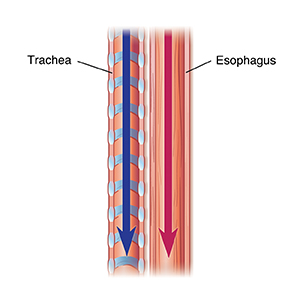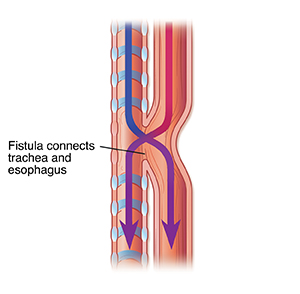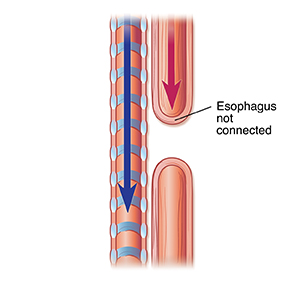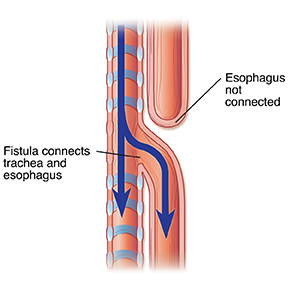Tracheoesophageal Fistula and Esophageal Atresia in the Newborn
The food pipe (esophagus) and windpipe (trachea) are 2 separate tubes. The esophagus runs behind the trachea inside the chest. Both tubes start at the throat. The food you eat travels down the esophagus into the stomach. The air you breathe travels down the trachea into the lungs. In some babies, these tubes don’t form the right way during pregnancy. This can lead to the problems described below. Your baby might have 1 or both of these problems.

What is tracheoesophageal fistula?
A tracheoesophageal fistula (TEF) is when there is an opening between the trachea and the esophagus. During pregnancy, the baby’s trachea and esophagus start out as 1 tube. During the first trimester, they should split into 2 tubes. If the wall between these 2 tubes doesn’t form fully, an opening remains. This is a fistula. When the baby eats, food can pass from the esophagus through the fistula into the trachea. This can cause breathing problems. The baby may have coughing and trouble breathing that gets worse when feeding.
 |
| With tracheoesophageal fistula, the trachea and esophagus are connected. Air can go into the stomach. Food can go into the lungs. |
What is esophageal atresia?
Esophageal atresia (EA) happens when the esophagus doesn’t join to the stomach, so food can’t get from the food pipe into the stomach. The main symptoms of EA are vomiting and drooling.

 |
| With this combination of fistula and atresia, air goes into the stomach and the lungs. Food can’t reach the stomach. |
How are the problems diagnosed?
If your baby has problems eating or trouble breathing, chokes during feeding, or coughs up a lot of fluid or mucus, they may have TEF or EA. These symptoms usually begin shortly after birth. Your health care provider will take an X-ray to learn more. This will show if the baby has 1 or both problems. The X-ray is often done with a feeding tube. It's put into the baby’s esophagus to see if the tube reaches the stomach.
How are the problems treated?
Surgery is needed for both of these problems. In many cases, a feeding tube is put into the baby's stomach to give nutrition. In other cases, your baby may get nourishment through an I.V. (intravenous) line until surgery can be done. A breathing machine may also be needed:
-
To treat TEF, the opening between the trachea and esophagus is closed during surgery.
-
To treat EA, the esophagus is joined to the stomach. In some cases, a tube with a weighted tip is put into the esophagus. This helps stretch the tissues of the food pipe to reach the stomach. It may take a few weeks before the esophagus is long enough. The baby will likely stay in the neonatal intensive care unit during this time. When the esophagus is long enough, surgery is done to attach it to the stomach.
What are the long-term effects?
-
Treatment of TEF often has a good result. Once the fistula is closed, many babies don’t have problems. But in some cases, ongoing breathing problems can occur.
-
EA can cause more serious problems. If the esophagus must be stretched, your baby may have lasting swallowing problems. Many babies develop GERD (gastroesophageal reflux disease). They are often given an acid blocker for a while after surgery. Also, your baby may have been fed through an I.V. (intravenous) line until after treatment. As a result, your baby may have trouble moving on to breast or bottle feedings. For instance, your baby may have trouble learning how to suckle and breathe at the same time. This may cause failure to gain weight. The health care provider can tell you more about how your baby is likely to progress.
-
A narrowing (stricture) can occur in the esophagus from scar tissue.
Online Medical Reviewer:
Dan Brennan MD
Online Medical Reviewer:
Lalitha Kadali
Online Medical Reviewer:
Rita Sather RN
Date Last Reviewed:
2/1/2025
© 2000-2025 The StayWell Company, LLC. All rights reserved. This information is not intended as a substitute for professional medical care. Always follow your healthcare professional's instructions.